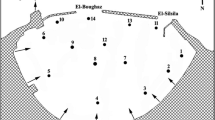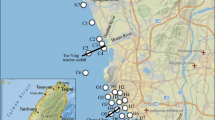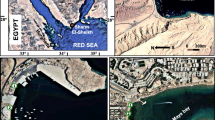Abstract
Bottom sediments of harbors in the South Korea have been long suspected for metal contamination due to ship-based and urban-based activities for the past several decades. A number of areas have been suspected to impair ecosystem services to the local residents and drawn complaints from main stakeholders. Twelve contamination suspected harbors were subject to evaluate the level of contamination of Cr, Ni, Cu, Zn, As, Cd, Pb and Hg. The level of sediment contamination for each metal was evaluated comparing the relative enrichment of a given metal to pollution-insensitive aluminum. Regional background concentration of a given metal was also determined based on its down core measurement and sediment texture. Ecological risk posed by the presence of heavy metals was evaluated using the sediment quality guidelines (SQGs) developed by United States National Ocean and Atmosphere Administration (US NOAA) as benchmarks for evaluating sediment chemistry to aquatic organisms. Cu, Zn, Cd, Pb and Hg in the surface sediment were found to be higher than a factor of 1.5 than background sediments, and the overall metal contaminations of surface sediment can be regarded as medium–high- to high-priority sites in the sense of SQGs.



Similar content being viewed by others
References
Baker, D. L., King, K. A., Kepner, W. G., & Krausmann, J. D. (1992). Pre-reconnaissance investigation of water quality, bottom sediment, and biota associated with irrigation drainage in Yuma Valley, Arizona. Phoenix, AZ: US Fish and Wildlife Service.
Balls, P. W., Hull, S., Miller, B. S., Pirie, J. M., & Proctor, W. (1997). Trace metal in Scottish Estuarine and coastal sediment. Marine Pollution Bulletin, 34, 42–50.
Cato, I. (1977). Recent sedimentological and geochemical conditions and pollution problems in two marine areas in southwestern Sweden. Striae, 6, 1–150.
Chapman, P. M., & Mann, G. S. (1999). Sediment quality values (SQVs) and ecological risk assessment (ERA). Marine Pollution Bulletin, 38(5), 339–344.
Chen, C. W., Kao, C. M., Chen, C. F., & Dong, C. D. (2007). Distribution and accumulation of heavy metals in the sediments of Kaohsiung Harbor, Taiwan. Chemosphere, 66, 1434–1440.
CRWQCB (California Regional Water Quality Control Board). (1999). Staff report on the establishment of shipyard sediment cleanup levels for National Steel and Shipbuilding Company and Southwest Marine, Inc. California Regional Water Quality Control Board San Diego Region. http://www.swrcb.ca.gov/rwqcb9/water_issues/programs/shipyards_sediment/docs/appndx_d.pdf. Accessed 15 June 2010.
Farkas, A., Erratico, C., & Viganò, L. (2007). Assessment of environmental significance of heavy metal pollution in surficial sediments of the River Po. Chemosphere, 68, 761–768.
Feng, H., Han, X., Zhang, W., & Yu, L. (2004). A preliminary study of heavy metal contamination in Yangtze River intertidal zone due to urbanization. Marine Pollution Bulletin, 49, 910–915.
Fukue, M., Yanai, M., Sato, Y., Fujikawa, T., Furukawa, Y., & Tani, T. (2006). Background values for evaluation of heavy metal contamination in sediments. Journal of Hazardous Materials, 136, 111–119.
Hong, G. H., Kim, S. H., Suedel, B. C., Clarke, J. U., & Kim, J. (2010). A decision-analysis approach for contaminated dredged material management in South Korea. Integrated Environmental Assessment and Management, 6, 72–82.
Hong, G. H., Park, Y. A., & Lee, K. W. (1983). Partitioning of heavy metals in sediments from Jinhae Bay, Korea. Journal of the Korean Society of Oceanography, 18, 100–104.
Hyun, S. M., Lee, C. H., Lee, T. H., & Choi, J. W. (2007). Anthropogenic contributions to heavy metal distributions in the surface sediments of Masan Bay, Korea. Marine Pollution Bulletin, 54, 1031–1071.
ICES (International Council for the Exploration of the Sea). (2003). Report of the working group on marine sediments in relation to pollution (WGMS). Tromsø, Norway. ICES CM 2003/E:04.
Kersten, M., & Smedes, F. (2002). Normalization procedures for sediment contaminants in spatial and temporal trend monitoring. Journal of Environmental Monitoring, 4, 109–115.
Kim, J., Kim, S. H., Hong, G. H., Suedel, B. C., & Clarke, J. (2010). Multicriteria decision analysis to assess options for managing contaminated sediments: Application to Southern Busan harbor, South Korea. Integrated Environmental Assessment and Management, 6, 61–71.
Long, E., Field, L., & MacDonald, D. (1998). Predicting toxicity in marine sediments with numerical sediment quality guidelines. Environmental Toxicology and Chemistry, 17, 714–727.
Long, E., & MacDonald, D. (1998). Recommended uses of empirically derived sediment quality guidelines for marine and estuarine ecosystems. Human Ecology Risk Assessment, 4, 1019–1039.
Long, E., MacDonald, D., Severn, C., & Hong, C. (2000). Classifying probabilities of acute toxicity in marine sediments with empirically derived sediment quality guidelines. Environmental Toxicology and Chemistry, 19, 2598–2601.
Long, E., MacDonald, D., Smith, S., & Calder, F. (1995). Incidence of adverse biological effects within ranges of chemical concentrations in marine and estuarine sediments. Environmental Management, 19, 81–97.
MacDonald, D., Ingersoll, C., & Berger, T. (2000). Development and evaluation of consensus-based sediment quality guidelines for freshwater ecosystems. Archives of Environmental Contamination and Toxicology, 39, 20–31.
MacDonald, D., & Smorong, D. (2006). An evaluation of sediment quality conditions in the vicinity of the Macaulay Point and Clover Point outfalls. Victoria, BC: British Columbia Ministry of Environment.
Marvin, C., Grapentine, L., & Painter, S. (2004). Application of a sediment quality index to the lower Laurentian Great Lakes. Environmental Monitoring and Assessment, 91, 1–16.
McCready, S., Birch, G., & Long, E. (2006). Metallic and organic contaminants in sediments of Sydney harbor, Australia and vicinity—A chemical dataset for evaluating sediment quality guidelines. Environment International, 32, 455–465.
Nasr, S. M., Okbah, M. A., & Kasern, S. M. (2006). Environmental assessment of heavy metal pollution in bottom sediments of Aden Port, Yemen. International Journal of Oceans and Oceanography, 1(1), 99–109.
OSPAR. (2005). Agreement on background concentrations for contaminants in seawater, biota and sediment (pp. 1–4). OSPAR convention for the protection of the marine environment of the North-East Atlantic. OSPAR Commission, Reference number: 2005–2006. http://www.ospar.org/documents/dbase/decrecs/agreements/05-06e_agreement%20Bcs.doc. Accessed 16 June 2010.
Paetzel, M., Nes, G., Leifsen, L., & Schrader, H. (2003). Sediment pollution in the Vagen, Bergen harbour, Norway. Environmental Geology, 43, 476–483.
Park, S. P., Kim, N. S., Yim, U. H., Shim, W. J., & Kim, G. B. (2009). Spatial and vertical distribution of polycyclic aromatic hydrocarbons in sediment of the shipyard area in Gohyeon Bay. Journal of the Korean society for Marine Environmental Engineering, 12(2), 68–74.
Rudnick, R. L., & Gao, S. (2004). Composition of the continental crust. In R. L. Rudnick (Ed.), The crust (Vol. 3, pp. 1–64). Treatise on Geochemistry, Amsterdam: Elsevier.
Santschi, P. H., Presley, B. J., Wade, T. L., Garcia-Romero, B., & Baskaran, M. (2001). Historical contamination of PAHs, PCBs, DDTs, and heavy metals in Mississippi River Delta, Galveston Bay and Tampa Bay sediment cores. Marine Environmental Research, 52, 51–79.
SFEI. (2000). 1998 Annual results: San Francisco Estuary regional monitoring program for trace substances. Richmond, CA: San Francisco Estuary Institute.
Shim, W. J., Hong, S. H., Yim, U. H., Kim, N. S., & Oh, J. R. (2002). Horizontal and vertical distribution of butyltin compounds in sediments from shipyard in Korea. Archives of Environmental Contamination and Toxicology, 43, 277–283.
Smith, R. G. (1993). Determination of mercury in environmental samples by isotope dilution/ICPMS. Analytical Chemistry, 65, 2485–2488.
Taylor, S. R., & McLennan, S. M. (1985). The continental crust: Its composition and evolution. Oxford: Blackwell Scientific.
Thomas, M., Petit, D., & Lamberts, L. (1984). Pond sediments as historical record of heavy metals fallout. Water, Air, and Soil pollution, 23, 51–59.
US EPA. (1998). Guidelines for ecological risk assessment. EPA/630/R-95/002F. p. 188.
Wang, F., & Chen, J. (2000). Relation of sediment characteristics to trace metal concentrations: A statistical study. Water Research, 34, 694–698.
Zhang, J. (1995). Geochemistry of trace metals from Chinese river/estuary systems: An overview. Estuarine, Coastal and Shelf Science, 41, 631–658.
Zhang, J., & Liu, C. (2002). Riverine composition and estuarine geochemistry of particulate metals in China—Weathering features, anthropogenic impact and chemical fluxes. Estuarine, Coastal and Shelf Science, 54, 1051–1070.
Zhang, L., Ye, X., Feng, H., Jing, Y., Ouyang, T., Yu, X., et al. (2007). Heavy metal contamination in western Xiamen Bay sediments and its vicinity, China. Marine Pollution Bulletin, 54, 974–982.
Acknowledgments
This study was funded by Korea Ocean Research and Development Institute Grants (PE27900, PE33300 and PE39300).
Author information
Authors and Affiliations
Corresponding author
Rights and permissions
About this article
Cite this article
Choi, K.Y., Kim, S.H., Hong, G.H. et al. Distributions of heavy metals in the sediments of South Korean harbors. Environ Geochem Health 34 (Suppl 1), 71–82 (2012). https://doi.org/10.1007/s10653-011-9413-3
Received:
Accepted:
Published:
Issue Date:
DOI: https://doi.org/10.1007/s10653-011-9413-3




